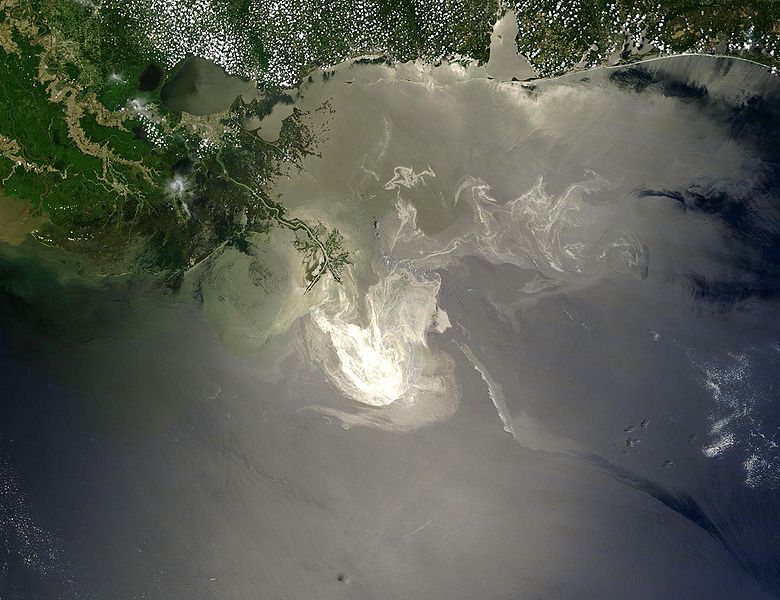

Towering flames illuminated the pre-dawn darkness, casting shadows on the ship Ocean Intervention III as it floated over the sunken remains of the Deepwater Horizon oil rig. The resonant hum of helicopters fused with the roar of fires on either side of the ship, and Chris Reddy could feel the heat on his face.
The night of June 21, 2010, Reddy and colleagues from the Woods Hole Oceanographic Institution were whisked off their research vessel Endeavor to collect samples directly from the blown Macondo well, which had been spewing oil and natural gas into the Gulf of Mexico for two months. They had 12 hours to do something that had never been done before: Use a robot arm to stick a special bottle directly into the hot hydrocarbons. Now, a year later, their analysis explains just what came out of the well, and sheds more light on what happened to it.
It turns out that certain chemicals in the well behave differently under high pressure than they do at the surface. This explains why some chemicals, but not others, made their way into the huge 22-mile plume of oil that Reddy et. al uncovered last summer. It also explains why some scientific papers examining the spill have seemed to contradict each other, according to Don Rice, director of the National Science Foundation’s chemical oceanography program.
“We now have a far better understanding of how and why an oil ‘spill’ into the ocean from below differs from one from above. The significance of this work extends well beyond the Gulf of Mexico,” he said in a statement.
One of the most confounding problems with the oil spill was scientific uncertainty — about how much oil was leaking into the Gulf, and about what exactly it was, both of which would explain where the oil would go. Reddy and colleagues needed to go directly to the source — the gusher at 5,000 feet below the surface — to see the compounds and therefore understand what would happen to the plume. This sample is called an “end member,” Reddy explained in an interview. A significant fraction of the gusher consisted of hot gas, mainly methane, so this proved a difficult task.
“If you tried to lower a traditional tool into that boiling cauldron and then close it and bring it up to the surface, that bottle would explode. A tiny methane bubble at 5,000 feet becomes a giant methane bubble at atmospheric pressure,” Reddy said.
The research team turned to Woods Hole geochemist Jeff Seewald, who developed a tool called an isobaric gas-tight sampler. It’s intended for collecting fluids from deep-sea hydrothermal vents. They used an oil industry ROV to place the IGT sampler directly over the broken riser pipe, and they collected the only undiluted, non-degraded sample from the spill.
The team found a gas-to-oil ratio of 1,600 cubic feet of gas per barrel of oil, according to a paper on the findings published this week in the Proceedings of the National Academy of Sciences and funded by the NSF. Based on this ratio, and using the federal government’s estimate of 4.1 million barrels of oil, Reddy et. al estimate 1.7 × 1011 g of methane, ethane and propane leaked into the Gulf. That’s about 105 tons. That’s a lot of methane.

But perhaps more interesting is the makeup of the plume, which mostly comprised benzene, toluene, ethybenzene, and total xylenes, or BTEX. BTEX compounds only represented about 2 percent of the oil that came out of the well, but almost 100 percent of the deep-sea plume. They apparently took a right-hand turn 3,000 feet below sea level, whereas the other hydrocarbons — like methane — degraded, washed on shore, were eaten by bacteria, or were burned in the fires that Reddy experienced while gathering his sample.
Studying the plume also required a bit of technical wizardry, Reddy said. WHOI researcher Richard Camilli built a super-sensitive mass spectrometer, which can instantly identify minute quantities of petroleum and other chemical compounds. This tool was used in the initial plume studies last summer, and it helped researchers quantify how the plume and the wellhead gusher were different.
“It shows some of these compounds are likely to evaporate quicker, at shallower depths. Oil is made up of many compounds, and they all have different chemical and physical properties. This work highlights that. Those properties determine what chemicals went into the plume,” Reddy said.
On the surface, this is all different — BTEX compounds quickly volatilize and evaporate into the atmosphere.
“In the case of the Deepwater Horizon oil spill, however, gas and oil experienced a significant residence time in the water column with no opportunity for the release of volatile species to the atmosphere,” the researchers write in the PNAS paper. “Hence, water-soluble petroleum compounds dissolved into the water column to a much greater extent than is typically observed for surface spills.”
The good news is that BTEX is not toxic to marine organisms until it reaches much higher levels than the researchers found in the Gulf. But neurological impairments can occur at lower concentrations, according to the National Science Foundation. It remains to be seen how the persistent BTEX may have affected sea life.
Meanwhile, Reddy and his colleages are still collecting samples from the beaches lining the Gulf Coast. He praised the National Science Foundation for funding ongoing oil spill research programs, which proved useful in the Deepwater Horizon crisis.
“We will continue to hunt and look for remnants of this oil for as long as we can be funded,” he said. “There’s a lot to be learned, about what compounds resist degradation from nature. It sheds tremendous light on this field.”
